Analysis of Teaching, Learning, and Assessment in Education
VerifiedAdded on 2023/01/12
|22
|7825
|1
Report
AI Summary
This report delves into the critical aspects of developing effective teaching, learning, and assessment practices within the field of education and training, with a specific focus on travel and tourism management. The report begins by defining behavior management and emphasizing its importance in the classroom, followed by an analysis of pedagogical principles, group and individual behavior management strategies, and relevant behavior management theories such as Maslow's hierarchy of needs and Herzberg's motivational theory. The report also evaluates the effectiveness of creative and innovative approaches to managing the learning environment, including learner-centered techniques, interactive methods, practical skill applications, and flexible online learning. Furthermore, the report examines the role of communication in teaching and learning, explores different communication theories, and analyzes various assessment types, their purposes, outcomes, and practical applications to meet diverse learner needs. The content is designed to provide comprehensive insights into creating and maintaining a conducive and effective learning environment.
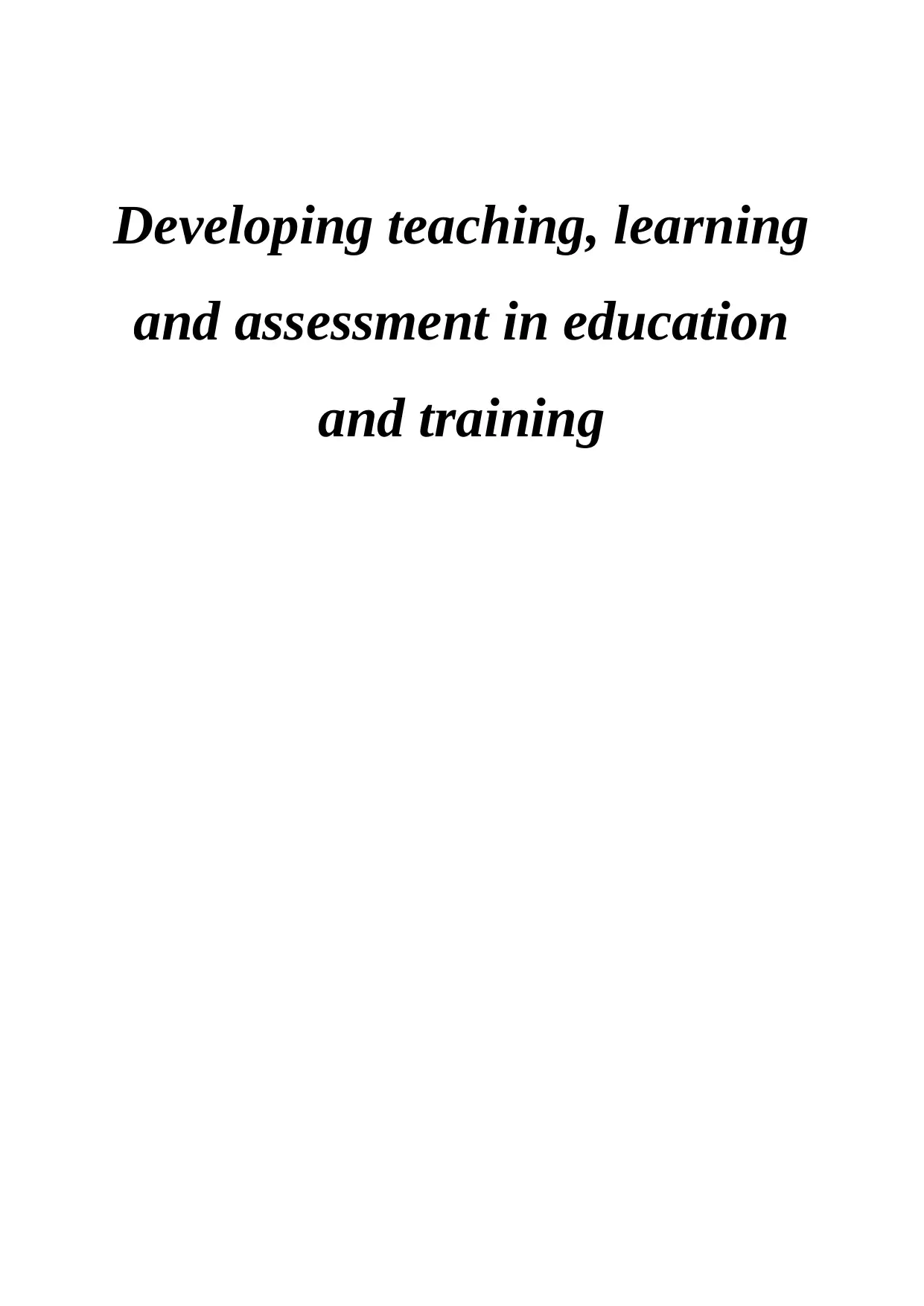
Developing teaching, learning
and assessment in education
and training
and assessment in education
and training
Paraphrase This Document
Need a fresh take? Get an instant paraphrase of this document with our AI Paraphraser
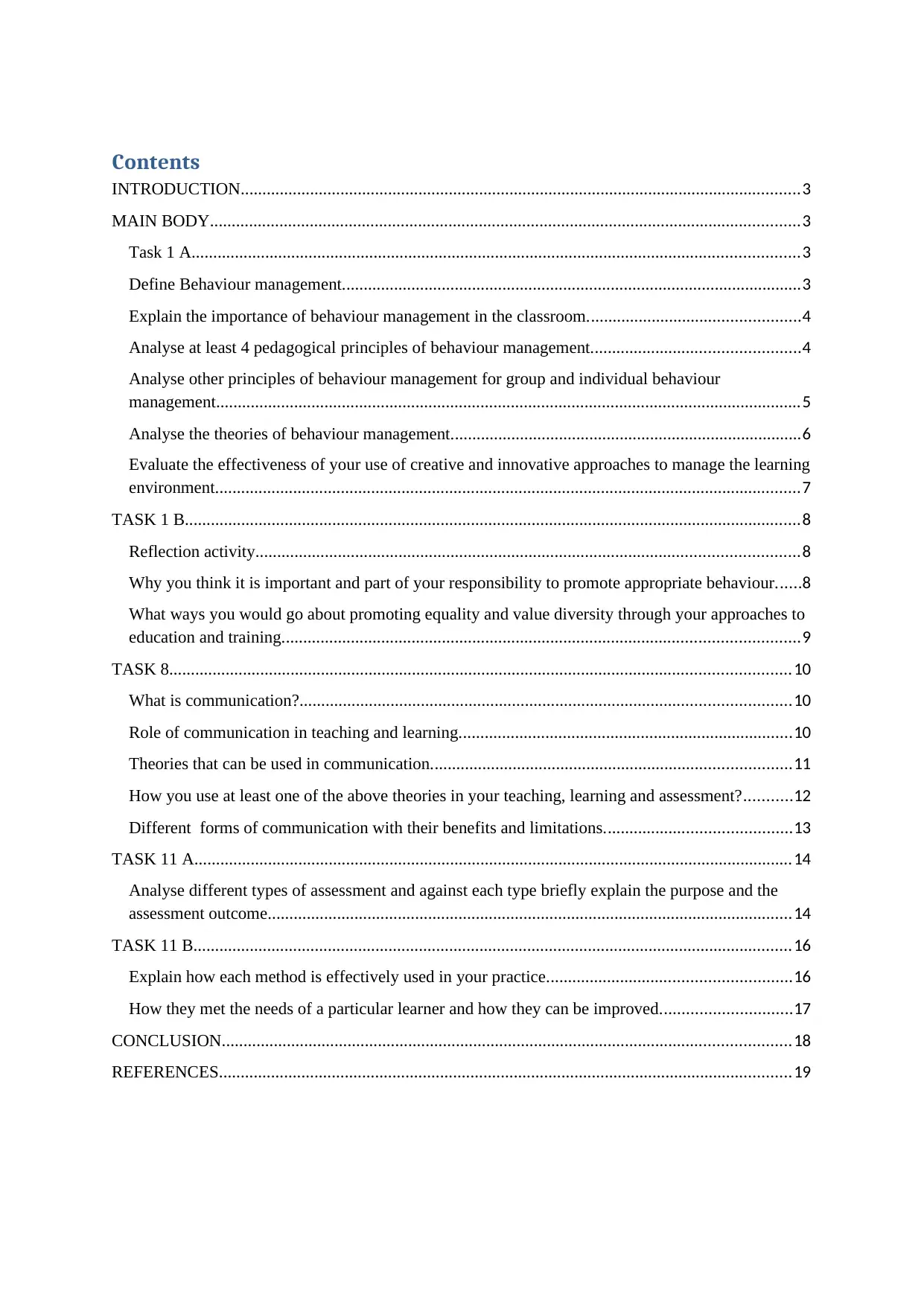
Contents
INTRODUCTION.................................................................................................................................3
MAIN BODY........................................................................................................................................3
Task 1 A............................................................................................................................................3
Define Behaviour management..........................................................................................................3
Explain the importance of behaviour management in the classroom.................................................4
Analyse at least 4 pedagogical principles of behaviour management................................................4
Analyse other principles of behaviour management for group and individual behaviour
management.......................................................................................................................................5
Analyse the theories of behaviour management.................................................................................6
Evaluate the effectiveness of your use of creative and innovative approaches to manage the learning
environment.......................................................................................................................................7
TASK 1 B..............................................................................................................................................8
Reflection activity.............................................................................................................................8
Why you think it is important and part of your responsibility to promote appropriate behaviour......8
What ways you would go about promoting equality and value diversity through your approaches to
education and training.......................................................................................................................9
TASK 8...............................................................................................................................................10
What is communication?.................................................................................................................10
Role of communication in teaching and learning.............................................................................10
Theories that can be used in communication...................................................................................11
How you use at least one of the above theories in your teaching, learning and assessment?...........12
Different forms of communication with their benefits and limitations...........................................13
TASK 11 A..........................................................................................................................................14
Analyse different types of assessment and against each type briefly explain the purpose and the
assessment outcome.........................................................................................................................14
TASK 11 B..........................................................................................................................................16
Explain how each method is effectively used in your practice........................................................16
How they met the needs of a particular learner and how they can be improved..............................17
CONCLUSION...................................................................................................................................18
REFERENCES....................................................................................................................................19
INTRODUCTION.................................................................................................................................3
MAIN BODY........................................................................................................................................3
Task 1 A............................................................................................................................................3
Define Behaviour management..........................................................................................................3
Explain the importance of behaviour management in the classroom.................................................4
Analyse at least 4 pedagogical principles of behaviour management................................................4
Analyse other principles of behaviour management for group and individual behaviour
management.......................................................................................................................................5
Analyse the theories of behaviour management.................................................................................6
Evaluate the effectiveness of your use of creative and innovative approaches to manage the learning
environment.......................................................................................................................................7
TASK 1 B..............................................................................................................................................8
Reflection activity.............................................................................................................................8
Why you think it is important and part of your responsibility to promote appropriate behaviour......8
What ways you would go about promoting equality and value diversity through your approaches to
education and training.......................................................................................................................9
TASK 8...............................................................................................................................................10
What is communication?.................................................................................................................10
Role of communication in teaching and learning.............................................................................10
Theories that can be used in communication...................................................................................11
How you use at least one of the above theories in your teaching, learning and assessment?...........12
Different forms of communication with their benefits and limitations...........................................13
TASK 11 A..........................................................................................................................................14
Analyse different types of assessment and against each type briefly explain the purpose and the
assessment outcome.........................................................................................................................14
TASK 11 B..........................................................................................................................................16
Explain how each method is effectively used in your practice........................................................16
How they met the needs of a particular learner and how they can be improved..............................17
CONCLUSION...................................................................................................................................18
REFERENCES....................................................................................................................................19
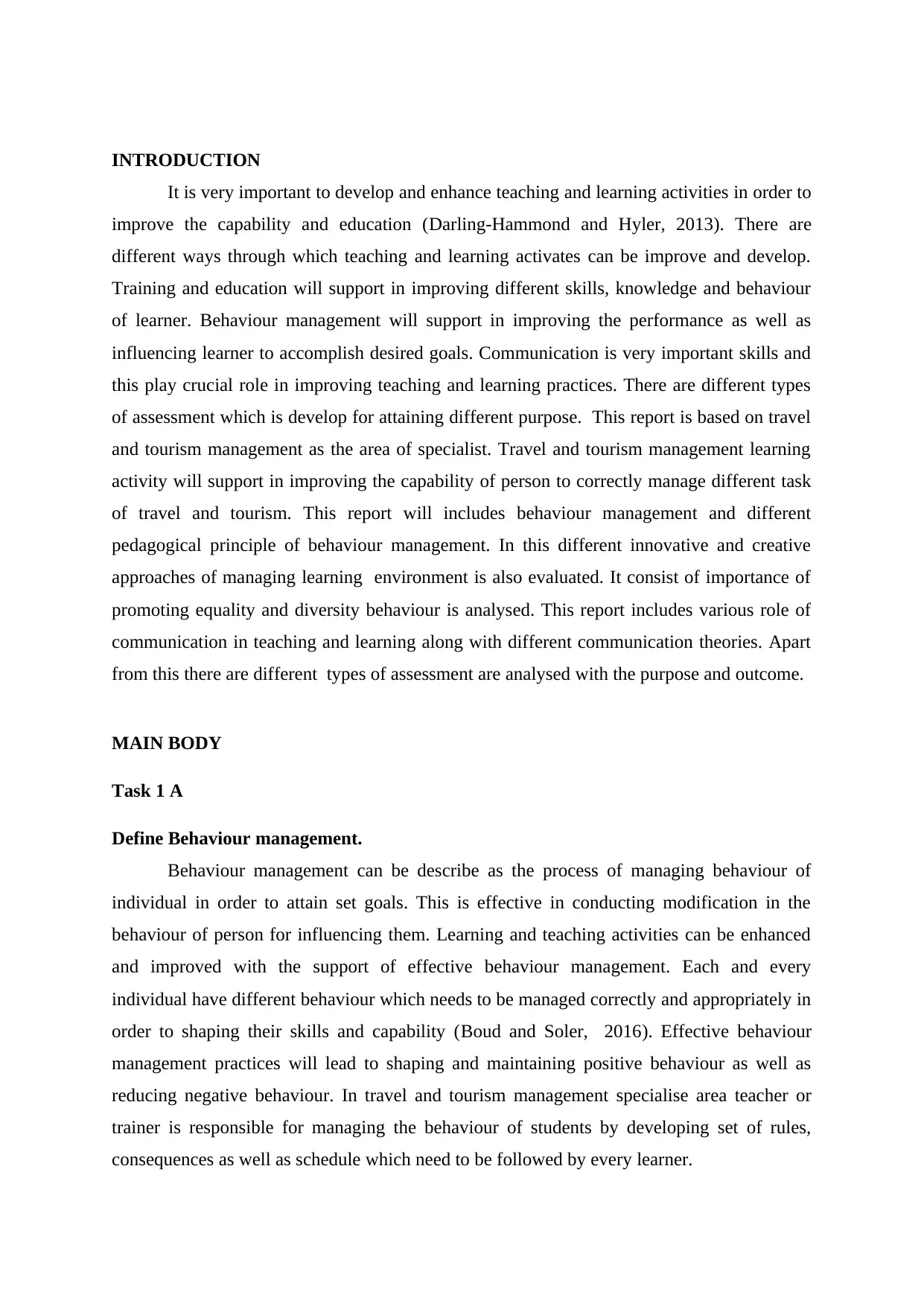
INTRODUCTION
It is very important to develop and enhance teaching and learning activities in order to
improve the capability and education (Darling-Hammond and Hyler, 2013). There are
different ways through which teaching and learning activates can be improve and develop.
Training and education will support in improving different skills, knowledge and behaviour
of learner. Behaviour management will support in improving the performance as well as
influencing learner to accomplish desired goals. Communication is very important skills and
this play crucial role in improving teaching and learning practices. There are different types
of assessment which is develop for attaining different purpose. This report is based on travel
and tourism management as the area of specialist. Travel and tourism management learning
activity will support in improving the capability of person to correctly manage different task
of travel and tourism. This report will includes behaviour management and different
pedagogical principle of behaviour management. In this different innovative and creative
approaches of managing learning environment is also evaluated. It consist of importance of
promoting equality and diversity behaviour is analysed. This report includes various role of
communication in teaching and learning along with different communication theories. Apart
from this there are different types of assessment are analysed with the purpose and outcome.
MAIN BODY
Task 1 A
Define Behaviour management.
Behaviour management can be describe as the process of managing behaviour of
individual in order to attain set goals. This is effective in conducting modification in the
behaviour of person for influencing them. Learning and teaching activities can be enhanced
and improved with the support of effective behaviour management. Each and every
individual have different behaviour which needs to be managed correctly and appropriately in
order to shaping their skills and capability (Boud and Soler, 2016). Effective behaviour
management practices will lead to shaping and maintaining positive behaviour as well as
reducing negative behaviour. In travel and tourism management specialise area teacher or
trainer is responsible for managing the behaviour of students by developing set of rules,
consequences as well as schedule which need to be followed by every learner.
It is very important to develop and enhance teaching and learning activities in order to
improve the capability and education (Darling-Hammond and Hyler, 2013). There are
different ways through which teaching and learning activates can be improve and develop.
Training and education will support in improving different skills, knowledge and behaviour
of learner. Behaviour management will support in improving the performance as well as
influencing learner to accomplish desired goals. Communication is very important skills and
this play crucial role in improving teaching and learning practices. There are different types
of assessment which is develop for attaining different purpose. This report is based on travel
and tourism management as the area of specialist. Travel and tourism management learning
activity will support in improving the capability of person to correctly manage different task
of travel and tourism. This report will includes behaviour management and different
pedagogical principle of behaviour management. In this different innovative and creative
approaches of managing learning environment is also evaluated. It consist of importance of
promoting equality and diversity behaviour is analysed. This report includes various role of
communication in teaching and learning along with different communication theories. Apart
from this there are different types of assessment are analysed with the purpose and outcome.
MAIN BODY
Task 1 A
Define Behaviour management.
Behaviour management can be describe as the process of managing behaviour of
individual in order to attain set goals. This is effective in conducting modification in the
behaviour of person for influencing them. Learning and teaching activities can be enhanced
and improved with the support of effective behaviour management. Each and every
individual have different behaviour which needs to be managed correctly and appropriately in
order to shaping their skills and capability (Boud and Soler, 2016). Effective behaviour
management practices will lead to shaping and maintaining positive behaviour as well as
reducing negative behaviour. In travel and tourism management specialise area teacher or
trainer is responsible for managing the behaviour of students by developing set of rules,
consequences as well as schedule which need to be followed by every learner.
⊘ This is a preview!⊘
Do you want full access?
Subscribe today to unlock all pages.

Trusted by 1+ million students worldwide
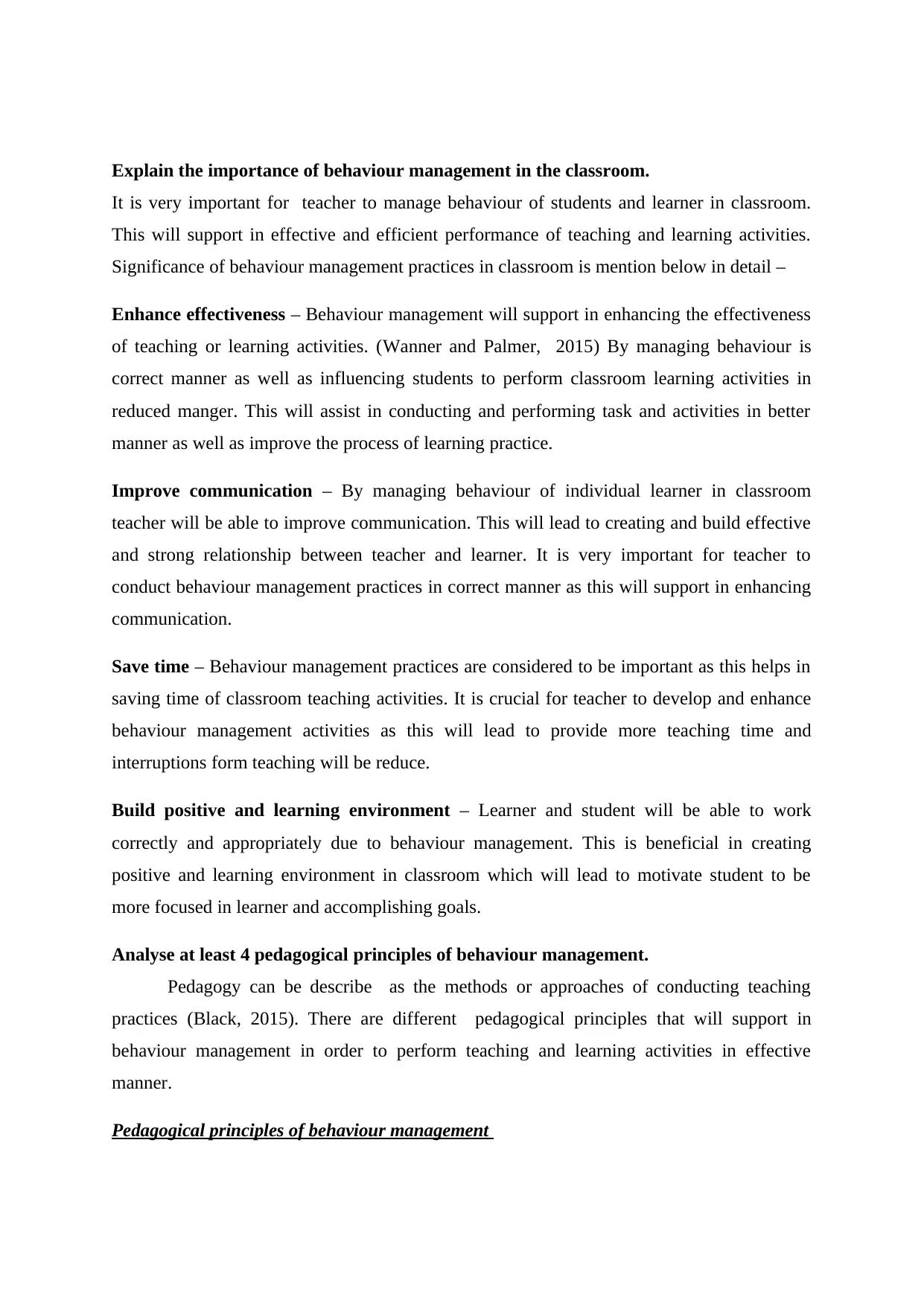
Explain the importance of behaviour management in the classroom.
It is very important for teacher to manage behaviour of students and learner in classroom.
This will support in effective and efficient performance of teaching and learning activities.
Significance of behaviour management practices in classroom is mention below in detail –
Enhance effectiveness – Behaviour management will support in enhancing the effectiveness
of teaching or learning activities. (Wanner and Palmer, 2015) By managing behaviour is
correct manner as well as influencing students to perform classroom learning activities in
reduced manger. This will assist in conducting and performing task and activities in better
manner as well as improve the process of learning practice.
Improve communication – By managing behaviour of individual learner in classroom
teacher will be able to improve communication. This will lead to creating and build effective
and strong relationship between teacher and learner. It is very important for teacher to
conduct behaviour management practices in correct manner as this will support in enhancing
communication.
Save time – Behaviour management practices are considered to be important as this helps in
saving time of classroom teaching activities. It is crucial for teacher to develop and enhance
behaviour management activities as this will lead to provide more teaching time and
interruptions form teaching will be reduce.
Build positive and learning environment – Learner and student will be able to work
correctly and appropriately due to behaviour management. This is beneficial in creating
positive and learning environment in classroom which will lead to motivate student to be
more focused in learner and accomplishing goals.
Analyse at least 4 pedagogical principles of behaviour management.
Pedagogy can be describe as the methods or approaches of conducting teaching
practices (Black, 2015). There are different pedagogical principles that will support in
behaviour management in order to perform teaching and learning activities in effective
manner.
Pedagogical principles of behaviour management
It is very important for teacher to manage behaviour of students and learner in classroom.
This will support in effective and efficient performance of teaching and learning activities.
Significance of behaviour management practices in classroom is mention below in detail –
Enhance effectiveness – Behaviour management will support in enhancing the effectiveness
of teaching or learning activities. (Wanner and Palmer, 2015) By managing behaviour is
correct manner as well as influencing students to perform classroom learning activities in
reduced manger. This will assist in conducting and performing task and activities in better
manner as well as improve the process of learning practice.
Improve communication – By managing behaviour of individual learner in classroom
teacher will be able to improve communication. This will lead to creating and build effective
and strong relationship between teacher and learner. It is very important for teacher to
conduct behaviour management practices in correct manner as this will support in enhancing
communication.
Save time – Behaviour management practices are considered to be important as this helps in
saving time of classroom teaching activities. It is crucial for teacher to develop and enhance
behaviour management activities as this will lead to provide more teaching time and
interruptions form teaching will be reduce.
Build positive and learning environment – Learner and student will be able to work
correctly and appropriately due to behaviour management. This is beneficial in creating
positive and learning environment in classroom which will lead to motivate student to be
more focused in learner and accomplishing goals.
Analyse at least 4 pedagogical principles of behaviour management.
Pedagogy can be describe as the methods or approaches of conducting teaching
practices (Black, 2015). There are different pedagogical principles that will support in
behaviour management in order to perform teaching and learning activities in effective
manner.
Pedagogical principles of behaviour management
Paraphrase This Document
Need a fresh take? Get an instant paraphrase of this document with our AI Paraphraser
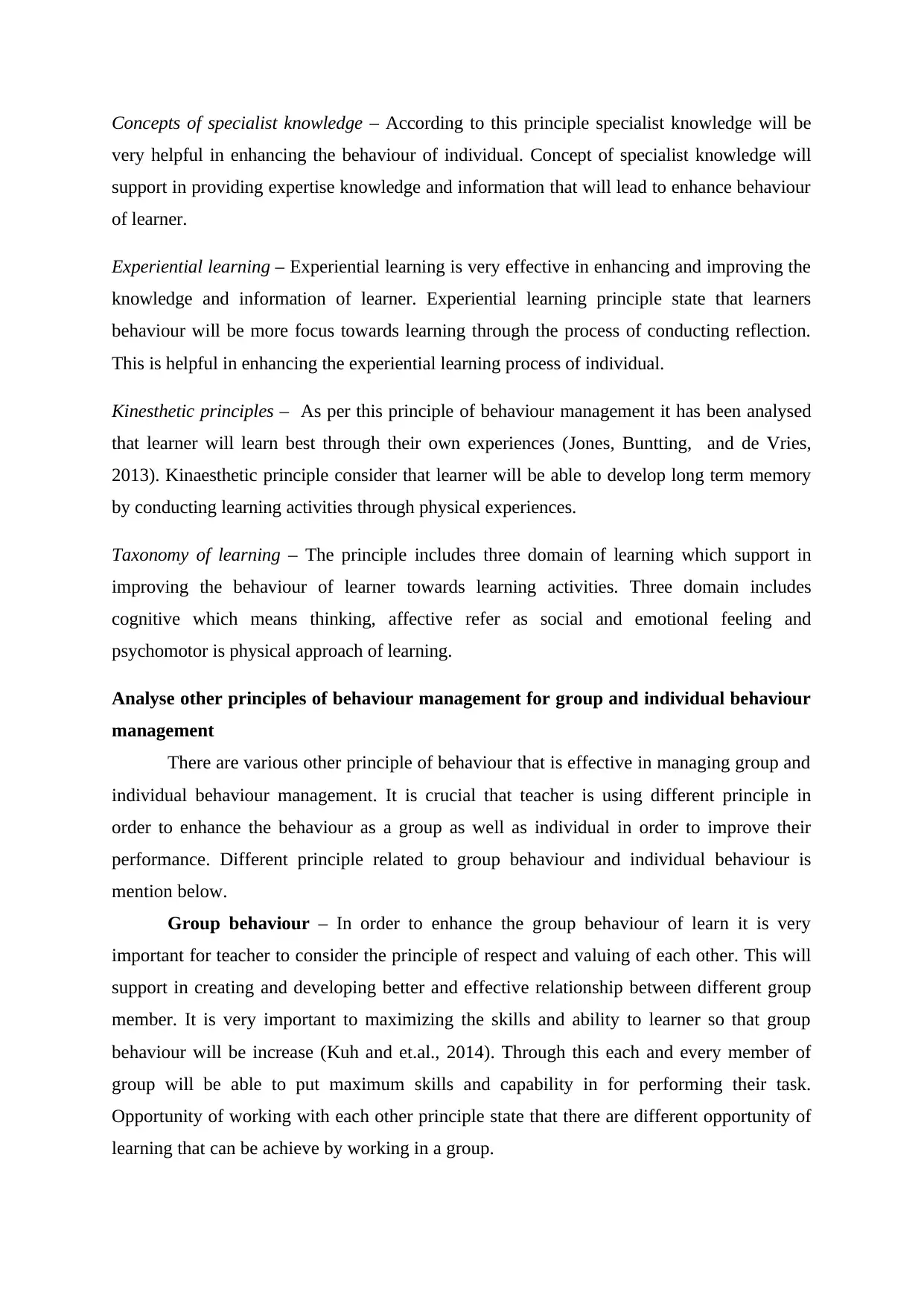
Concepts of specialist knowledge – According to this principle specialist knowledge will be
very helpful in enhancing the behaviour of individual. Concept of specialist knowledge will
support in providing expertise knowledge and information that will lead to enhance behaviour
of learner.
Experiential learning – Experiential learning is very effective in enhancing and improving the
knowledge and information of learner. Experiential learning principle state that learners
behaviour will be more focus towards learning through the process of conducting reflection.
This is helpful in enhancing the experiential learning process of individual.
Kinesthetic principles – As per this principle of behaviour management it has been analysed
that learner will learn best through their own experiences (Jones, Buntting, and de Vries,
2013). Kinaesthetic principle consider that learner will be able to develop long term memory
by conducting learning activities through physical experiences.
Taxonomy of learning – The principle includes three domain of learning which support in
improving the behaviour of learner towards learning activities. Three domain includes
cognitive which means thinking, affective refer as social and emotional feeling and
psychomotor is physical approach of learning.
Analyse other principles of behaviour management for group and individual behaviour
management
There are various other principle of behaviour that is effective in managing group and
individual behaviour management. It is crucial that teacher is using different principle in
order to enhance the behaviour as a group as well as individual in order to improve their
performance. Different principle related to group behaviour and individual behaviour is
mention below.
Group behaviour – In order to enhance the group behaviour of learn it is very
important for teacher to consider the principle of respect and valuing of each other. This will
support in creating and developing better and effective relationship between different group
member. It is very important to maximizing the skills and ability to learner so that group
behaviour will be increase (Kuh and et.al., 2014). Through this each and every member of
group will be able to put maximum skills and capability in for performing their task.
Opportunity of working with each other principle state that there are different opportunity of
learning that can be achieve by working in a group.
very helpful in enhancing the behaviour of individual. Concept of specialist knowledge will
support in providing expertise knowledge and information that will lead to enhance behaviour
of learner.
Experiential learning – Experiential learning is very effective in enhancing and improving the
knowledge and information of learner. Experiential learning principle state that learners
behaviour will be more focus towards learning through the process of conducting reflection.
This is helpful in enhancing the experiential learning process of individual.
Kinesthetic principles – As per this principle of behaviour management it has been analysed
that learner will learn best through their own experiences (Jones, Buntting, and de Vries,
2013). Kinaesthetic principle consider that learner will be able to develop long term memory
by conducting learning activities through physical experiences.
Taxonomy of learning – The principle includes three domain of learning which support in
improving the behaviour of learner towards learning activities. Three domain includes
cognitive which means thinking, affective refer as social and emotional feeling and
psychomotor is physical approach of learning.
Analyse other principles of behaviour management for group and individual behaviour
management
There are various other principle of behaviour that is effective in managing group and
individual behaviour management. It is crucial that teacher is using different principle in
order to enhance the behaviour as a group as well as individual in order to improve their
performance. Different principle related to group behaviour and individual behaviour is
mention below.
Group behaviour – In order to enhance the group behaviour of learn it is very
important for teacher to consider the principle of respect and valuing of each other. This will
support in creating and developing better and effective relationship between different group
member. It is very important to maximizing the skills and ability to learner so that group
behaviour will be increase (Kuh and et.al., 2014). Through this each and every member of
group will be able to put maximum skills and capability in for performing their task.
Opportunity of working with each other principle state that there are different opportunity of
learning that can be achieve by working in a group.
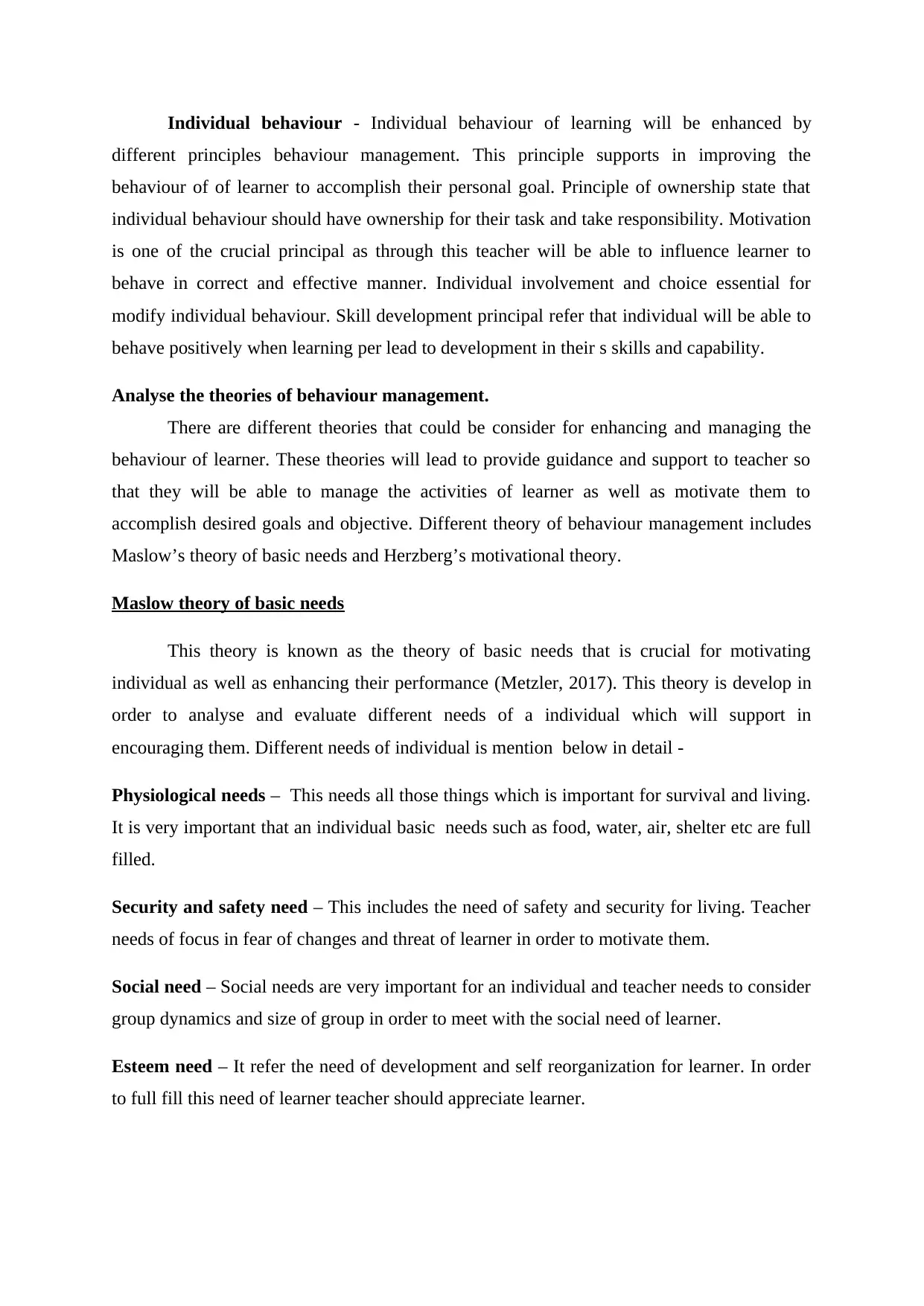
Individual behaviour - Individual behaviour of learning will be enhanced by
different principles behaviour management. This principle supports in improving the
behaviour of of learner to accomplish their personal goal. Principle of ownership state that
individual behaviour should have ownership for their task and take responsibility. Motivation
is one of the crucial principal as through this teacher will be able to influence learner to
behave in correct and effective manner. Individual involvement and choice essential for
modify individual behaviour. Skill development principal refer that individual will be able to
behave positively when learning per lead to development in their s skills and capability.
Analyse the theories of behaviour management.
There are different theories that could be consider for enhancing and managing the
behaviour of learner. These theories will lead to provide guidance and support to teacher so
that they will be able to manage the activities of learner as well as motivate them to
accomplish desired goals and objective. Different theory of behaviour management includes
Maslow’s theory of basic needs and Herzberg’s motivational theory.
Maslow theory of basic needs
This theory is known as the theory of basic needs that is crucial for motivating
individual as well as enhancing their performance (Metzler, 2017). This theory is develop in
order to analyse and evaluate different needs of a individual which will support in
encouraging them. Different needs of individual is mention below in detail -
Physiological needs – This needs all those things which is important for survival and living.
It is very important that an individual basic needs such as food, water, air, shelter etc are full
filled.
Security and safety need – This includes the need of safety and security for living. Teacher
needs of focus in fear of changes and threat of learner in order to motivate them.
Social need – Social needs are very important for an individual and teacher needs to consider
group dynamics and size of group in order to meet with the social need of learner.
Esteem need – It refer the need of development and self reorganization for learner. In order
to full fill this need of learner teacher should appreciate learner.
different principles behaviour management. This principle supports in improving the
behaviour of of learner to accomplish their personal goal. Principle of ownership state that
individual behaviour should have ownership for their task and take responsibility. Motivation
is one of the crucial principal as through this teacher will be able to influence learner to
behave in correct and effective manner. Individual involvement and choice essential for
modify individual behaviour. Skill development principal refer that individual will be able to
behave positively when learning per lead to development in their s skills and capability.
Analyse the theories of behaviour management.
There are different theories that could be consider for enhancing and managing the
behaviour of learner. These theories will lead to provide guidance and support to teacher so
that they will be able to manage the activities of learner as well as motivate them to
accomplish desired goals and objective. Different theory of behaviour management includes
Maslow’s theory of basic needs and Herzberg’s motivational theory.
Maslow theory of basic needs
This theory is known as the theory of basic needs that is crucial for motivating
individual as well as enhancing their performance (Metzler, 2017). This theory is develop in
order to analyse and evaluate different needs of a individual which will support in
encouraging them. Different needs of individual is mention below in detail -
Physiological needs – This needs all those things which is important for survival and living.
It is very important that an individual basic needs such as food, water, air, shelter etc are full
filled.
Security and safety need – This includes the need of safety and security for living. Teacher
needs of focus in fear of changes and threat of learner in order to motivate them.
Social need – Social needs are very important for an individual and teacher needs to consider
group dynamics and size of group in order to meet with the social need of learner.
Esteem need – It refer the need of development and self reorganization for learner. In order
to full fill this need of learner teacher should appreciate learner.
⊘ This is a preview!⊘
Do you want full access?
Subscribe today to unlock all pages.

Trusted by 1+ million students worldwide
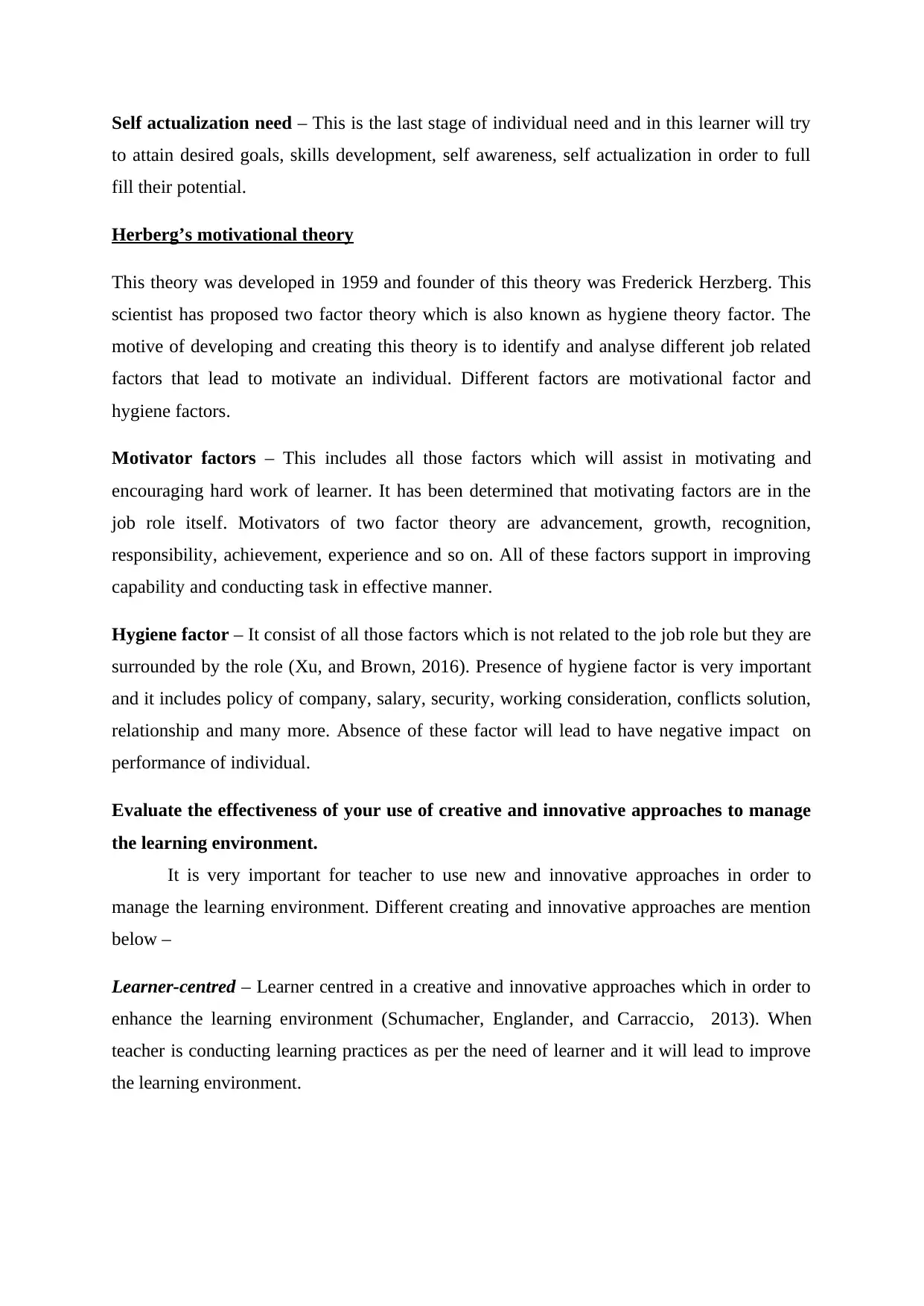
Self actualization need – This is the last stage of individual need and in this learner will try
to attain desired goals, skills development, self awareness, self actualization in order to full
fill their potential.
Herberg’s motivational theory
This theory was developed in 1959 and founder of this theory was Frederick Herzberg. This
scientist has proposed two factor theory which is also known as hygiene theory factor. The
motive of developing and creating this theory is to identify and analyse different job related
factors that lead to motivate an individual. Different factors are motivational factor and
hygiene factors.
Motivator factors – This includes all those factors which will assist in motivating and
encouraging hard work of learner. It has been determined that motivating factors are in the
job role itself. Motivators of two factor theory are advancement, growth, recognition,
responsibility, achievement, experience and so on. All of these factors support in improving
capability and conducting task in effective manner.
Hygiene factor – It consist of all those factors which is not related to the job role but they are
surrounded by the role (Xu, and Brown, 2016). Presence of hygiene factor is very important
and it includes policy of company, salary, security, working consideration, conflicts solution,
relationship and many more. Absence of these factor will lead to have negative impact on
performance of individual.
Evaluate the effectiveness of your use of creative and innovative approaches to manage
the learning environment.
It is very important for teacher to use new and innovative approaches in order to
manage the learning environment. Different creating and innovative approaches are mention
below –
Learner-centred – Learner centred in a creative and innovative approaches which in order to
enhance the learning environment (Schumacher, Englander, and Carraccio, 2013). When
teacher is conducting learning practices as per the need of learner and it will lead to improve
the learning environment.
to attain desired goals, skills development, self awareness, self actualization in order to full
fill their potential.
Herberg’s motivational theory
This theory was developed in 1959 and founder of this theory was Frederick Herzberg. This
scientist has proposed two factor theory which is also known as hygiene theory factor. The
motive of developing and creating this theory is to identify and analyse different job related
factors that lead to motivate an individual. Different factors are motivational factor and
hygiene factors.
Motivator factors – This includes all those factors which will assist in motivating and
encouraging hard work of learner. It has been determined that motivating factors are in the
job role itself. Motivators of two factor theory are advancement, growth, recognition,
responsibility, achievement, experience and so on. All of these factors support in improving
capability and conducting task in effective manner.
Hygiene factor – It consist of all those factors which is not related to the job role but they are
surrounded by the role (Xu, and Brown, 2016). Presence of hygiene factor is very important
and it includes policy of company, salary, security, working consideration, conflicts solution,
relationship and many more. Absence of these factor will lead to have negative impact on
performance of individual.
Evaluate the effectiveness of your use of creative and innovative approaches to manage
the learning environment.
It is very important for teacher to use new and innovative approaches in order to
manage the learning environment. Different creating and innovative approaches are mention
below –
Learner-centred – Learner centred in a creative and innovative approaches which in order to
enhance the learning environment (Schumacher, Englander, and Carraccio, 2013). When
teacher is conducting learning practices as per the need of learner and it will lead to improve
the learning environment.
Paraphrase This Document
Need a fresh take? Get an instant paraphrase of this document with our AI Paraphraser
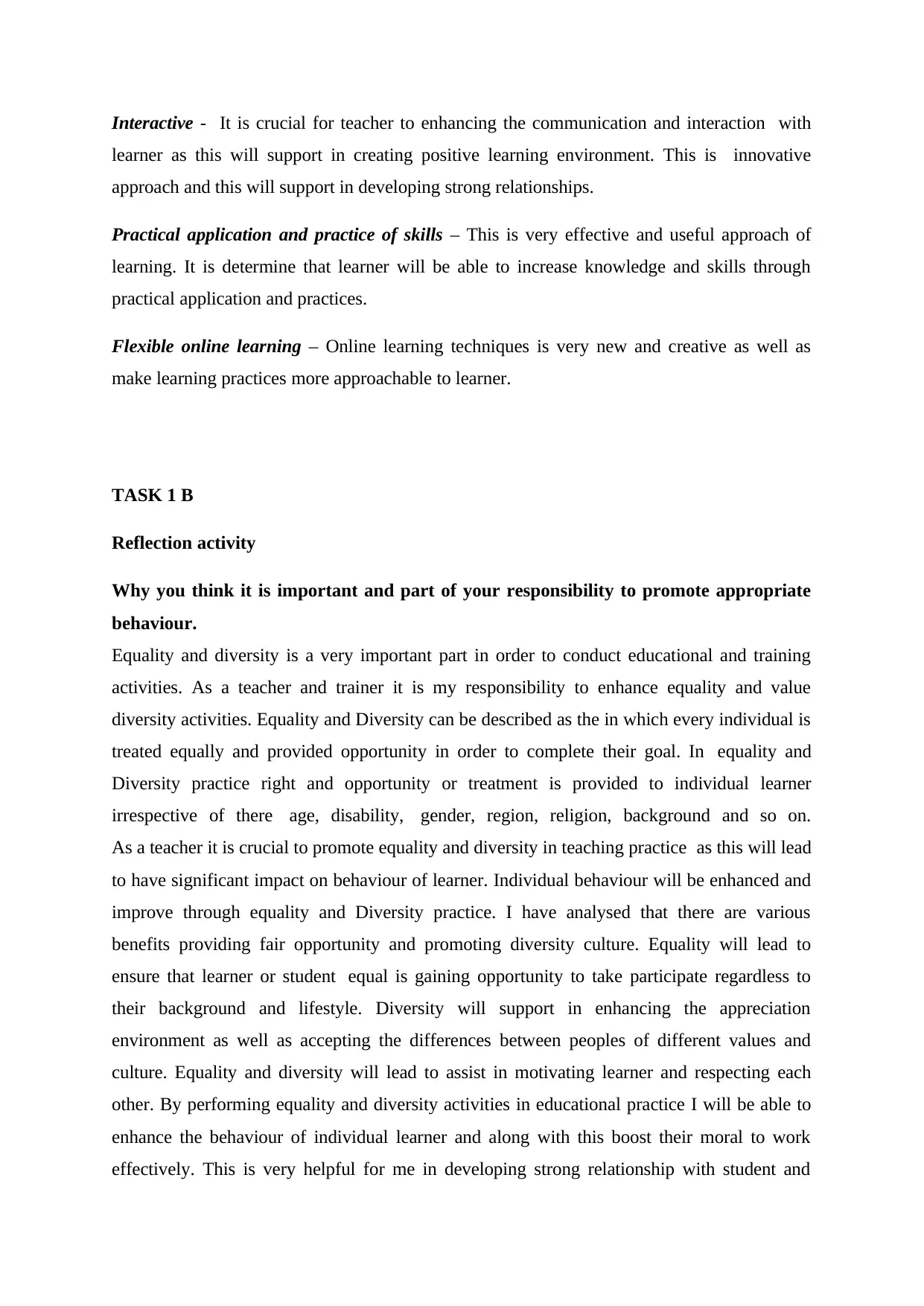
Interactive - It is crucial for teacher to enhancing the communication and interaction with
learner as this will support in creating positive learning environment. This is innovative
approach and this will support in developing strong relationships.
Practical application and practice of skills – This is very effective and useful approach of
learning. It is determine that learner will be able to increase knowledge and skills through
practical application and practices.
Flexible online learning – Online learning techniques is very new and creative as well as
make learning practices more approachable to learner.
TASK 1 B
Reflection activity
Why you think it is important and part of your responsibility to promote appropriate
behaviour.
Equality and diversity is a very important part in order to conduct educational and training
activities. As a teacher and trainer it is my responsibility to enhance equality and value
diversity activities. Equality and Diversity can be described as the in which every individual is
treated equally and provided opportunity in order to complete their goal. In equality and
Diversity practice right and opportunity or treatment is provided to individual learner
irrespective of there age, disability, gender, region, religion, background and so on.
As a teacher it is crucial to promote equality and diversity in teaching practice as this will lead
to have significant impact on behaviour of learner. Individual behaviour will be enhanced and
improve through equality and Diversity practice. I have analysed that there are various
benefits providing fair opportunity and promoting diversity culture. Equality will lead to
ensure that learner or student equal is gaining opportunity to take participate regardless to
their background and lifestyle. Diversity will support in enhancing the appreciation
environment as well as accepting the differences between peoples of different values and
culture. Equality and diversity will lead to assist in motivating learner and respecting each
other. By performing equality and diversity activities in educational practice I will be able to
enhance the behaviour of individual learner and along with this boost their moral to work
effectively. This is very helpful for me in developing strong relationship with student and
learner as this will support in creating positive learning environment. This is innovative
approach and this will support in developing strong relationships.
Practical application and practice of skills – This is very effective and useful approach of
learning. It is determine that learner will be able to increase knowledge and skills through
practical application and practices.
Flexible online learning – Online learning techniques is very new and creative as well as
make learning practices more approachable to learner.
TASK 1 B
Reflection activity
Why you think it is important and part of your responsibility to promote appropriate
behaviour.
Equality and diversity is a very important part in order to conduct educational and training
activities. As a teacher and trainer it is my responsibility to enhance equality and value
diversity activities. Equality and Diversity can be described as the in which every individual is
treated equally and provided opportunity in order to complete their goal. In equality and
Diversity practice right and opportunity or treatment is provided to individual learner
irrespective of there age, disability, gender, region, religion, background and so on.
As a teacher it is crucial to promote equality and diversity in teaching practice as this will lead
to have significant impact on behaviour of learner. Individual behaviour will be enhanced and
improve through equality and Diversity practice. I have analysed that there are various
benefits providing fair opportunity and promoting diversity culture. Equality will lead to
ensure that learner or student equal is gaining opportunity to take participate regardless to
their background and lifestyle. Diversity will support in enhancing the appreciation
environment as well as accepting the differences between peoples of different values and
culture. Equality and diversity will lead to assist in motivating learner and respecting each
other. By performing equality and diversity activities in educational practice I will be able to
enhance the behaviour of individual learner and along with this boost their moral to work
effectively. This is very helpful for me in developing strong relationship with student and
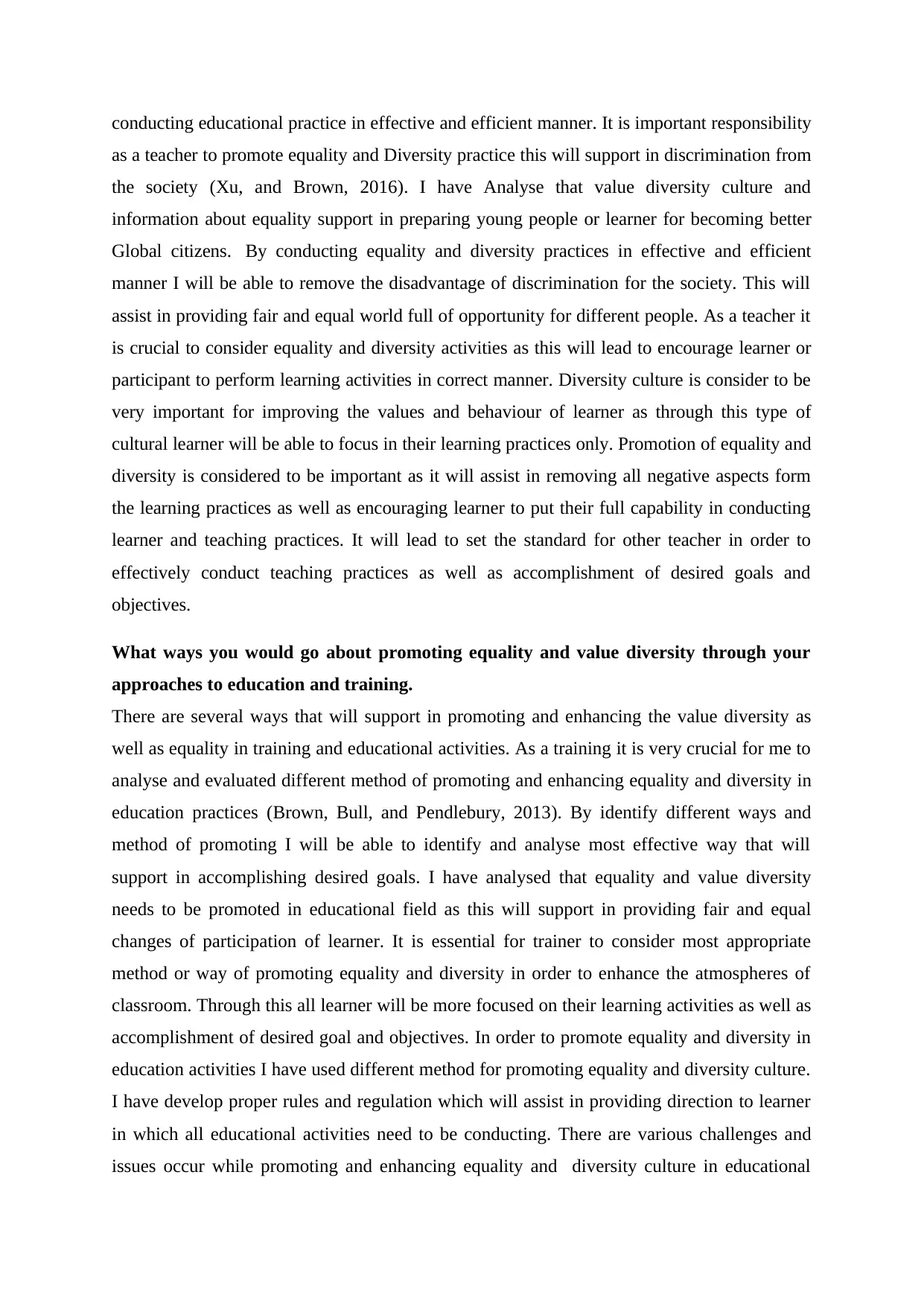
conducting educational practice in effective and efficient manner. It is important responsibility
as a teacher to promote equality and Diversity practice this will support in discrimination from
the society (Xu, and Brown, 2016). I have Analyse that value diversity culture and
information about equality support in preparing young people or learner for becoming better
Global citizens. By conducting equality and diversity practices in effective and efficient
manner I will be able to remove the disadvantage of discrimination for the society. This will
assist in providing fair and equal world full of opportunity for different people. As a teacher it
is crucial to consider equality and diversity activities as this will lead to encourage learner or
participant to perform learning activities in correct manner. Diversity culture is consider to be
very important for improving the values and behaviour of learner as through this type of
cultural learner will be able to focus in their learning practices only. Promotion of equality and
diversity is considered to be important as it will assist in removing all negative aspects form
the learning practices as well as encouraging learner to put their full capability in conducting
learner and teaching practices. It will lead to set the standard for other teacher in order to
effectively conduct teaching practices as well as accomplishment of desired goals and
objectives.
What ways you would go about promoting equality and value diversity through your
approaches to education and training.
There are several ways that will support in promoting and enhancing the value diversity as
well as equality in training and educational activities. As a training it is very crucial for me to
analyse and evaluated different method of promoting and enhancing equality and diversity in
education practices (Brown, Bull, and Pendlebury, 2013). By identify different ways and
method of promoting I will be able to identify and analyse most effective way that will
support in accomplishing desired goals. I have analysed that equality and value diversity
needs to be promoted in educational field as this will support in providing fair and equal
changes of participation of learner. It is essential for trainer to consider most appropriate
method or way of promoting equality and diversity in order to enhance the atmospheres of
classroom. Through this all learner will be more focused on their learning activities as well as
accomplishment of desired goal and objectives. In order to promote equality and diversity in
education activities I have used different method for promoting equality and diversity culture.
I have develop proper rules and regulation which will assist in providing direction to learner
in which all educational activities need to be conducting. There are various challenges and
issues occur while promoting and enhancing equality and diversity culture in educational
as a teacher to promote equality and Diversity practice this will support in discrimination from
the society (Xu, and Brown, 2016). I have Analyse that value diversity culture and
information about equality support in preparing young people or learner for becoming better
Global citizens. By conducting equality and diversity practices in effective and efficient
manner I will be able to remove the disadvantage of discrimination for the society. This will
assist in providing fair and equal world full of opportunity for different people. As a teacher it
is crucial to consider equality and diversity activities as this will lead to encourage learner or
participant to perform learning activities in correct manner. Diversity culture is consider to be
very important for improving the values and behaviour of learner as through this type of
cultural learner will be able to focus in their learning practices only. Promotion of equality and
diversity is considered to be important as it will assist in removing all negative aspects form
the learning practices as well as encouraging learner to put their full capability in conducting
learner and teaching practices. It will lead to set the standard for other teacher in order to
effectively conduct teaching practices as well as accomplishment of desired goals and
objectives.
What ways you would go about promoting equality and value diversity through your
approaches to education and training.
There are several ways that will support in promoting and enhancing the value diversity as
well as equality in training and educational activities. As a training it is very crucial for me to
analyse and evaluated different method of promoting and enhancing equality and diversity in
education practices (Brown, Bull, and Pendlebury, 2013). By identify different ways and
method of promoting I will be able to identify and analyse most effective way that will
support in accomplishing desired goals. I have analysed that equality and value diversity
needs to be promoted in educational field as this will support in providing fair and equal
changes of participation of learner. It is essential for trainer to consider most appropriate
method or way of promoting equality and diversity in order to enhance the atmospheres of
classroom. Through this all learner will be more focused on their learning activities as well as
accomplishment of desired goal and objectives. In order to promote equality and diversity in
education activities I have used different method for promoting equality and diversity culture.
I have develop proper rules and regulation which will assist in providing direction to learner
in which all educational activities need to be conducting. There are various challenges and
issues occur while promoting and enhancing equality and diversity culture in educational
⊘ This is a preview!⊘
Do you want full access?
Subscribe today to unlock all pages.

Trusted by 1+ million students worldwide
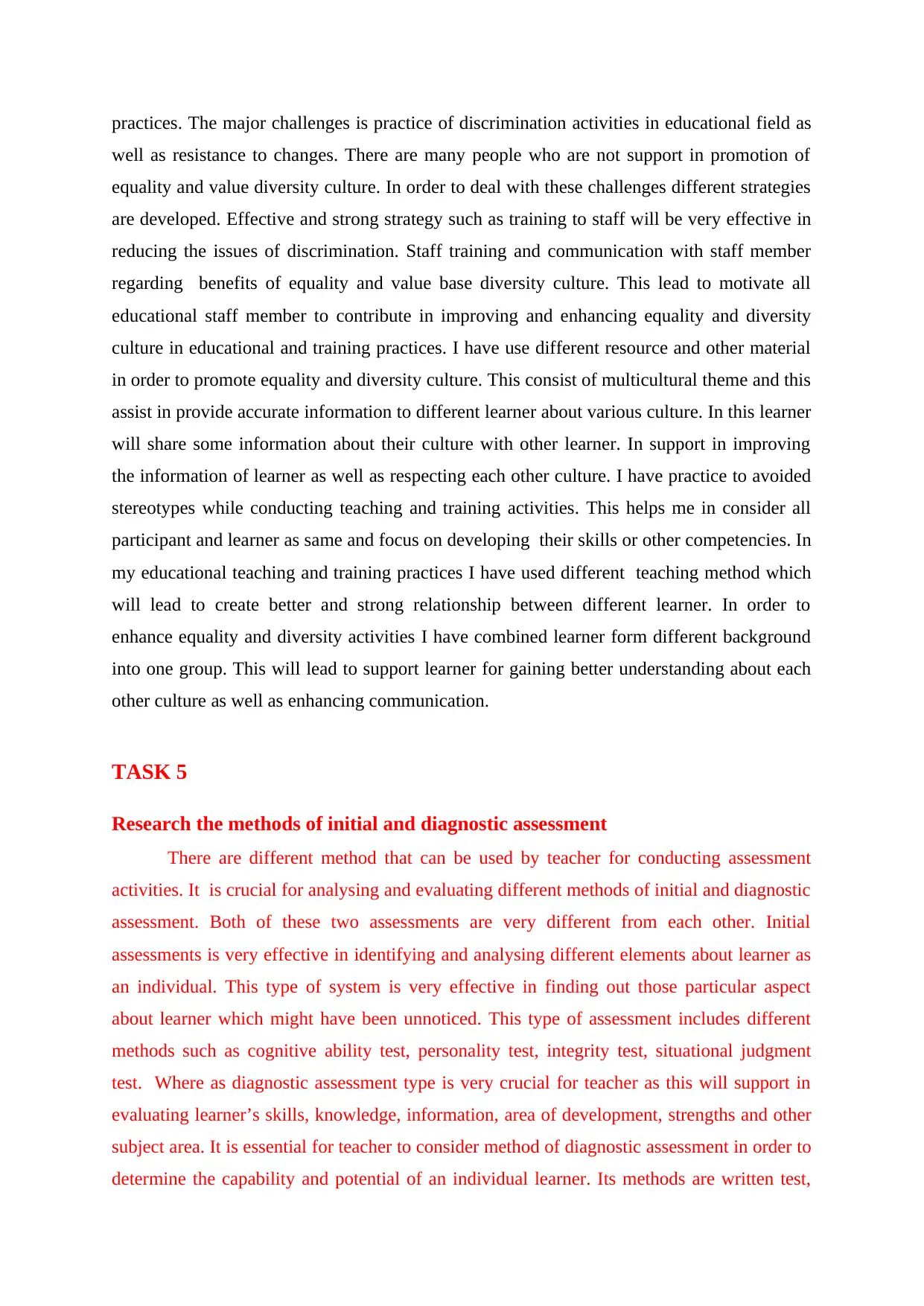
practices. The major challenges is practice of discrimination activities in educational field as
well as resistance to changes. There are many people who are not support in promotion of
equality and value diversity culture. In order to deal with these challenges different strategies
are developed. Effective and strong strategy such as training to staff will be very effective in
reducing the issues of discrimination. Staff training and communication with staff member
regarding benefits of equality and value base diversity culture. This lead to motivate all
educational staff member to contribute in improving and enhancing equality and diversity
culture in educational and training practices. I have use different resource and other material
in order to promote equality and diversity culture. This consist of multicultural theme and this
assist in provide accurate information to different learner about various culture. In this learner
will share some information about their culture with other learner. In support in improving
the information of learner as well as respecting each other culture. I have practice to avoided
stereotypes while conducting teaching and training activities. This helps me in consider all
participant and learner as same and focus on developing their skills or other competencies. In
my educational teaching and training practices I have used different teaching method which
will lead to create better and strong relationship between different learner. In order to
enhance equality and diversity activities I have combined learner form different background
into one group. This will lead to support learner for gaining better understanding about each
other culture as well as enhancing communication.
TASK 5
Research the methods of initial and diagnostic assessment
There are different method that can be used by teacher for conducting assessment
activities. It is crucial for analysing and evaluating different methods of initial and diagnostic
assessment. Both of these two assessments are very different from each other. Initial
assessments is very effective in identifying and analysing different elements about learner as
an individual. This type of system is very effective in finding out those particular aspect
about learner which might have been unnoticed. This type of assessment includes different
methods such as cognitive ability test, personality test, integrity test, situational judgment
test. Where as diagnostic assessment type is very crucial for teacher as this will support in
evaluating learner’s skills, knowledge, information, area of development, strengths and other
subject area. It is essential for teacher to consider method of diagnostic assessment in order to
determine the capability and potential of an individual learner. Its methods are written test,
well as resistance to changes. There are many people who are not support in promotion of
equality and value diversity culture. In order to deal with these challenges different strategies
are developed. Effective and strong strategy such as training to staff will be very effective in
reducing the issues of discrimination. Staff training and communication with staff member
regarding benefits of equality and value base diversity culture. This lead to motivate all
educational staff member to contribute in improving and enhancing equality and diversity
culture in educational and training practices. I have use different resource and other material
in order to promote equality and diversity culture. This consist of multicultural theme and this
assist in provide accurate information to different learner about various culture. In this learner
will share some information about their culture with other learner. In support in improving
the information of learner as well as respecting each other culture. I have practice to avoided
stereotypes while conducting teaching and training activities. This helps me in consider all
participant and learner as same and focus on developing their skills or other competencies. In
my educational teaching and training practices I have used different teaching method which
will lead to create better and strong relationship between different learner. In order to
enhance equality and diversity activities I have combined learner form different background
into one group. This will lead to support learner for gaining better understanding about each
other culture as well as enhancing communication.
TASK 5
Research the methods of initial and diagnostic assessment
There are different method that can be used by teacher for conducting assessment
activities. It is crucial for analysing and evaluating different methods of initial and diagnostic
assessment. Both of these two assessments are very different from each other. Initial
assessments is very effective in identifying and analysing different elements about learner as
an individual. This type of system is very effective in finding out those particular aspect
about learner which might have been unnoticed. This type of assessment includes different
methods such as cognitive ability test, personality test, integrity test, situational judgment
test. Where as diagnostic assessment type is very crucial for teacher as this will support in
evaluating learner’s skills, knowledge, information, area of development, strengths and other
subject area. It is essential for teacher to consider method of diagnostic assessment in order to
determine the capability and potential of an individual learner. Its methods are written test,
Paraphrase This Document
Need a fresh take? Get an instant paraphrase of this document with our AI Paraphraser
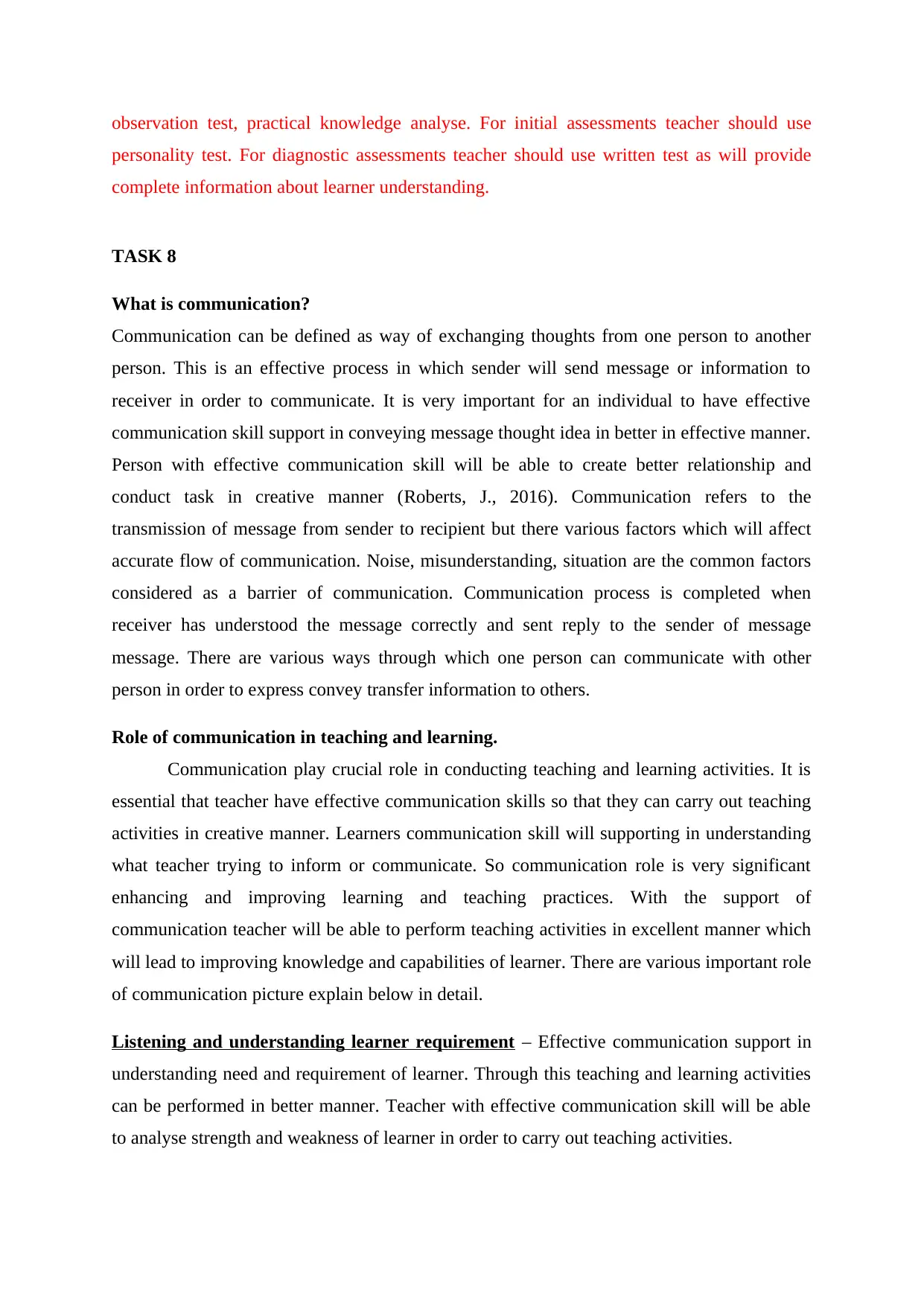
observation test, practical knowledge analyse. For initial assessments teacher should use
personality test. For diagnostic assessments teacher should use written test as will provide
complete information about learner understanding.
TASK 8
What is communication?
Communication can be defined as way of exchanging thoughts from one person to another
person. This is an effective process in which sender will send message or information to
receiver in order to communicate. It is very important for an individual to have effective
communication skill support in conveying message thought idea in better in effective manner.
Person with effective communication skill will be able to create better relationship and
conduct task in creative manner (Roberts, J., 2016). Communication refers to the
transmission of message from sender to recipient but there various factors which will affect
accurate flow of communication. Noise, misunderstanding, situation are the common factors
considered as a barrier of communication. Communication process is completed when
receiver has understood the message correctly and sent reply to the sender of message
message. There are various ways through which one person can communicate with other
person in order to express convey transfer information to others.
Role of communication in teaching and learning.
Communication play crucial role in conducting teaching and learning activities. It is
essential that teacher have effective communication skills so that they can carry out teaching
activities in creative manner. Learners communication skill will supporting in understanding
what teacher trying to inform or communicate. So communication role is very significant
enhancing and improving learning and teaching practices. With the support of
communication teacher will be able to perform teaching activities in excellent manner which
will lead to improving knowledge and capabilities of learner. There are various important role
of communication picture explain below in detail.
Listening and understanding learner requirement – Effective communication support in
understanding need and requirement of learner. Through this teaching and learning activities
can be performed in better manner. Teacher with effective communication skill will be able
to analyse strength and weakness of learner in order to carry out teaching activities.
personality test. For diagnostic assessments teacher should use written test as will provide
complete information about learner understanding.
TASK 8
What is communication?
Communication can be defined as way of exchanging thoughts from one person to another
person. This is an effective process in which sender will send message or information to
receiver in order to communicate. It is very important for an individual to have effective
communication skill support in conveying message thought idea in better in effective manner.
Person with effective communication skill will be able to create better relationship and
conduct task in creative manner (Roberts, J., 2016). Communication refers to the
transmission of message from sender to recipient but there various factors which will affect
accurate flow of communication. Noise, misunderstanding, situation are the common factors
considered as a barrier of communication. Communication process is completed when
receiver has understood the message correctly and sent reply to the sender of message
message. There are various ways through which one person can communicate with other
person in order to express convey transfer information to others.
Role of communication in teaching and learning.
Communication play crucial role in conducting teaching and learning activities. It is
essential that teacher have effective communication skills so that they can carry out teaching
activities in creative manner. Learners communication skill will supporting in understanding
what teacher trying to inform or communicate. So communication role is very significant
enhancing and improving learning and teaching practices. With the support of
communication teacher will be able to perform teaching activities in excellent manner which
will lead to improving knowledge and capabilities of learner. There are various important role
of communication picture explain below in detail.
Listening and understanding learner requirement – Effective communication support in
understanding need and requirement of learner. Through this teaching and learning activities
can be performed in better manner. Teacher with effective communication skill will be able
to analyse strength and weakness of learner in order to carry out teaching activities.
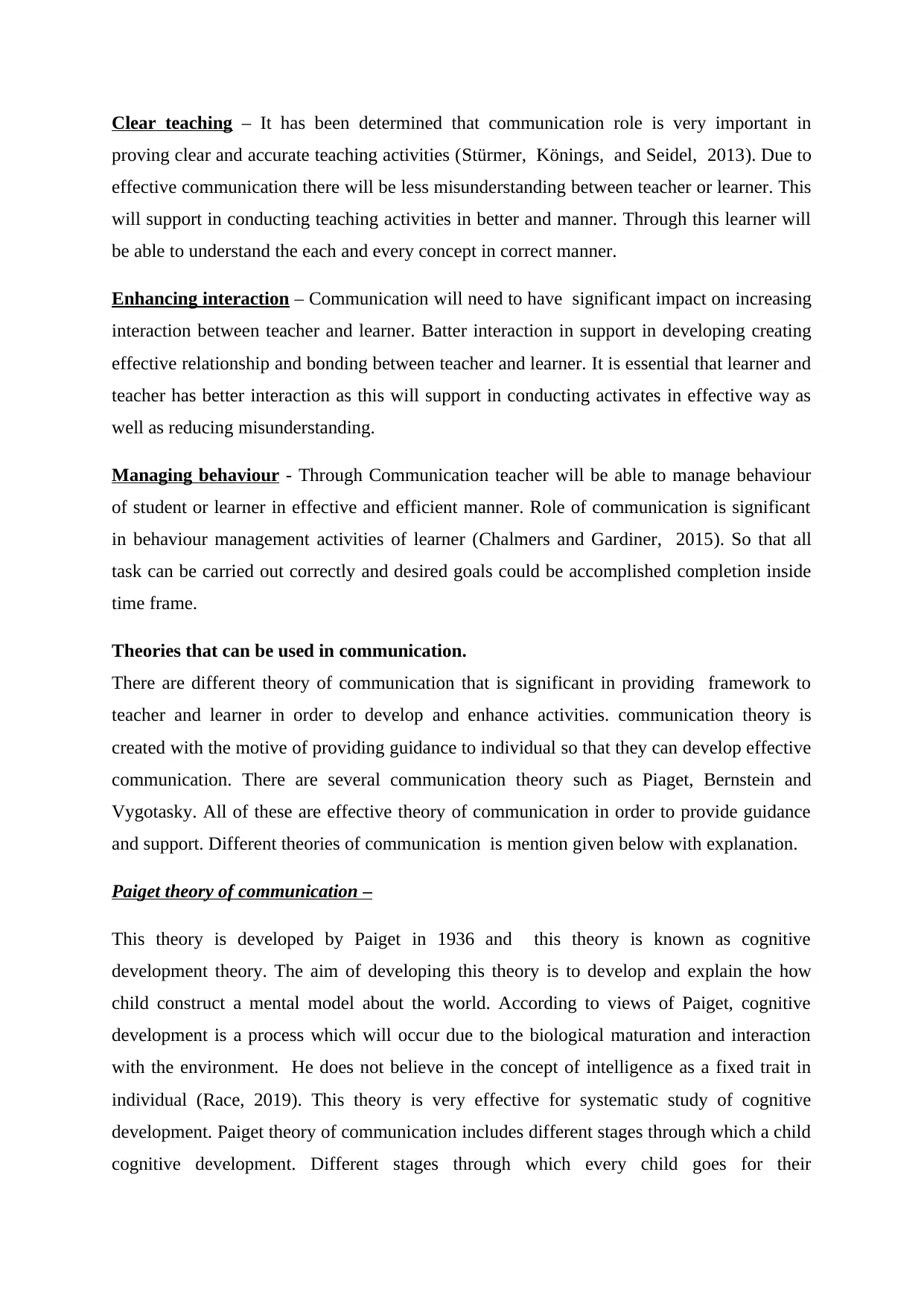
Clear teaching – It has been determined that communication role is very important in
proving clear and accurate teaching activities (Stürmer, Könings, and Seidel, 2013). Due to
effective communication there will be less misunderstanding between teacher or learner. This
will support in conducting teaching activities in better and manner. Through this learner will
be able to understand the each and every concept in correct manner.
Enhancing interaction – Communication will need to have significant impact on increasing
interaction between teacher and learner. Batter interaction in support in developing creating
effective relationship and bonding between teacher and learner. It is essential that learner and
teacher has better interaction as this will support in conducting activates in effective way as
well as reducing misunderstanding.
Managing behaviour - Through Communication teacher will be able to manage behaviour
of student or learner in effective and efficient manner. Role of communication is significant
in behaviour management activities of learner (Chalmers and Gardiner, 2015). So that all
task can be carried out correctly and desired goals could be accomplished completion inside
time frame.
Theories that can be used in communication.
There are different theory of communication that is significant in providing framework to
teacher and learner in order to develop and enhance activities. communication theory is
created with the motive of providing guidance to individual so that they can develop effective
communication. There are several communication theory such as Piaget, Bernstein and
Vygotasky. All of these are effective theory of communication in order to provide guidance
and support. Different theories of communication is mention given below with explanation.
Paiget theory of communication –
This theory is developed by Paiget in 1936 and this theory is known as cognitive
development theory. The aim of developing this theory is to develop and explain the how
child construct a mental model about the world. According to views of Paiget, cognitive
development is a process which will occur due to the biological maturation and interaction
with the environment. He does not believe in the concept of intelligence as a fixed trait in
individual (Race, 2019). This theory is very effective for systematic study of cognitive
development. Paiget theory of communication includes different stages through which a child
cognitive development. Different stages through which every child goes for their
proving clear and accurate teaching activities (Stürmer, Könings, and Seidel, 2013). Due to
effective communication there will be less misunderstanding between teacher or learner. This
will support in conducting teaching activities in better and manner. Through this learner will
be able to understand the each and every concept in correct manner.
Enhancing interaction – Communication will need to have significant impact on increasing
interaction between teacher and learner. Batter interaction in support in developing creating
effective relationship and bonding between teacher and learner. It is essential that learner and
teacher has better interaction as this will support in conducting activates in effective way as
well as reducing misunderstanding.
Managing behaviour - Through Communication teacher will be able to manage behaviour
of student or learner in effective and efficient manner. Role of communication is significant
in behaviour management activities of learner (Chalmers and Gardiner, 2015). So that all
task can be carried out correctly and desired goals could be accomplished completion inside
time frame.
Theories that can be used in communication.
There are different theory of communication that is significant in providing framework to
teacher and learner in order to develop and enhance activities. communication theory is
created with the motive of providing guidance to individual so that they can develop effective
communication. There are several communication theory such as Piaget, Bernstein and
Vygotasky. All of these are effective theory of communication in order to provide guidance
and support. Different theories of communication is mention given below with explanation.
Paiget theory of communication –
This theory is developed by Paiget in 1936 and this theory is known as cognitive
development theory. The aim of developing this theory is to develop and explain the how
child construct a mental model about the world. According to views of Paiget, cognitive
development is a process which will occur due to the biological maturation and interaction
with the environment. He does not believe in the concept of intelligence as a fixed trait in
individual (Race, 2019). This theory is very effective for systematic study of cognitive
development. Paiget theory of communication includes different stages through which a child
cognitive development. Different stages through which every child goes for their
⊘ This is a preview!⊘
Do you want full access?
Subscribe today to unlock all pages.

Trusted by 1+ million students worldwide
1 out of 22
Related Documents
Your All-in-One AI-Powered Toolkit for Academic Success.
+13062052269
info@desklib.com
Available 24*7 on WhatsApp / Email
![[object Object]](/_next/static/media/star-bottom.7253800d.svg)
Unlock your academic potential
Copyright © 2020–2025 A2Z Services. All Rights Reserved. Developed and managed by ZUCOL.





